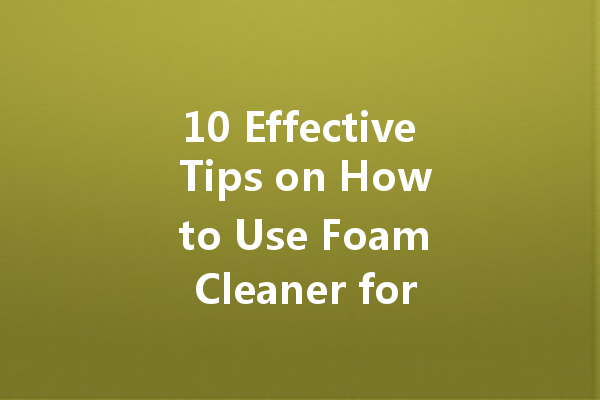Foam cleaners are popular cleaning agents that can make tough cleaning tasks much easier. They are primarily designed to tackle dirt, grease, and grime on various surfaces. Whether you’re cleaning your home, kitchen, or even your car, knowing how to use foam cleaner effectively can ensure optimal results. In this article, we will provide you with ten effective tips on using foam cleaners for ultimate cleanliness.
Understanding Foam Cleaners
Before diving into the tips, it’s important to understand what foam cleaners are. These cleaning agents are formulated to create a thick foam when sprayed, allowing them to cling to surfaces and break down dirt and grease. Their powerful composition can make cleaning quicker and more efficient.
Not all foam cleaners are created equal; choosing the right one for your specific cleaning task is crucial. Some foam cleaners are designed for kitchen use, while others may be intended for bathroom fixtures or even vehicle interiors. Always check the product label to ensure it is suitable for the surface you plan to clean.
Once you’ve selected a foam cleaner, take a moment to read the manufacturer’s instructions. This will provide valuable insights into the recommended usage, drying times, and any safety precautions. Following these guidelines can enhance the effectiveness of the cleaner and keep you safe from any harmful chemicals.
Before applying the foam cleaner, it’s important to prepare the surface you’ll be cleaning. Remove any loose debris and dust to ensure that the foam can penetrate and adhere properly. For stubborn stains, you may want to pre-treat the area with water or a mild detergent.
When you’re ready to use the foam cleaner, hold the canister at the recommended distance—usually about 6-12 inches away from the surface. Press the nozzle firmly to release the foam, ensuring that you apply it evenly. Avoid spraying too much in one spot, as this can lead to drip marks and uneven cleaning.
After applying the foam cleaner, allow it to sit for the manufacturer-recommended time. This dwell time is essential for the cleaner to break down dirt and grime effectively. Rushing this step may result in less effective cleaning, so be patient and let the foam do its job.

Once the foam has had time to work its magic, grab a clean cloth or sponge to wipe away the residue. Use a damp cloth for rinsing, especially in kitchens and bathrooms where sanitization is key. For tougher stains, you may need to apply a little elbow grease to remove any remaining residue.
After cleaning, it’s important to check for any streaks or leftover foam. In some cases, you may need to wipe the area again with a clean, damp cloth to ensure a polished finish. This is particularly important on shiny surfaces like glass or stainless steel.
After you’re done cleaning, make sure to store the foam cleaner properly. Keep it in a cool, dry place away from direct sunlight and ensure that the nozzle is clean and clear of any foam residue. Proper storage will prolong the life of the cleaner and ensure it’s effective for your next cleanup.
Some foam cleaners contain strong chemicals that can irritate your skin or respiratory system. It’s advisable to wear gloves and a mask when using these products, particularly in poorly ventilated areas. Protecting yourself will make your cleaning experience safer and more enjoyable.
Finally, if you are unsure how a foam cleaner will interact with a specific surface, test it in a hidden area first. This will help you gauge how the cleaner affects the material without causing visible damage. Once you’re confident about its effects, proceed to clean the larger areas.
Conclusion
Using foam cleaner can simplify your cleaning tasks and achieve impressive results when done correctly. By following these ten effective tips—ranging from choosing the right product to proper application and storage—you can ensure that your cleaning is efficient, safe, and thorough. Embrace the power of foam cleaners and enjoy a cleaner, fresher living space.
